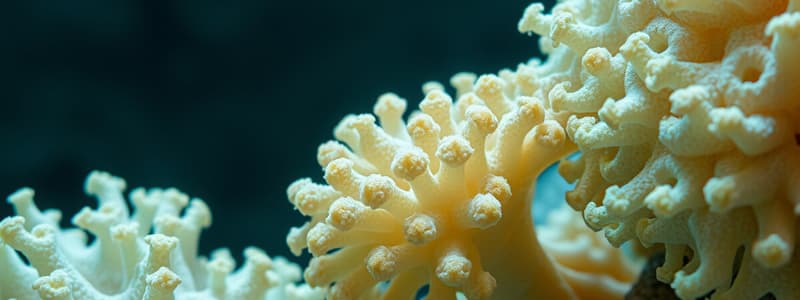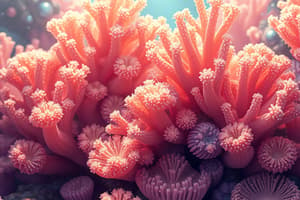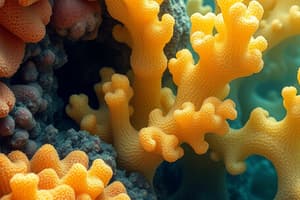Podcast
Questions and Answers
What is an osculum?
What is an osculum?
- A large opening on a sponge through which filtered water is expelled (correct)
- A type of spicule
- A small opening on a sponge
- A body form of sponge
What is a spicule?
What is a spicule?
Needlelike structures that give support and protection to the sponge body.
What is a choanocyte?
What is a choanocyte?
Cells that line the body cavity and have flagella that circulate water.
What is budding?
What is budding?
What is Class Calcarea?
What is Class Calcarea?
What is Class Hexactinellida?
What is Class Hexactinellida?
What is Class Demospongiae?
What is Class Demospongiae?
Describe the Ascon body form.
Describe the Ascon body form.
Describe the Sycon body form.
Describe the Sycon body form.
Describe the Leucon body form.
Describe the Leucon body form.
What are ostia?
What are ostia?
What are pinacocytes?
What are pinacocytes?
What is the mesohyl layer?
What is the mesohyl layer?
What are mesenchyme cells (amoebocytes)?
What are mesenchyme cells (amoebocytes)?
What is spongin?
What is spongin?
What is a gemmule?
What is a gemmule?
What is fragmentation?
What is fragmentation?
What does it mean if an organism is monoecious?
What does it mean if an organism is monoecious?
What is asexual reproduction?
What is asexual reproduction?
What is sexual reproduction?
What is sexual reproduction?
What is Phylum Porifera?
What is Phylum Porifera?
What is Class Homoscleromorpha?
What is Class Homoscleromorpha?
What are filter feeders?
What are filter feeders?
Flashcards
Osculum
Osculum
Large opening in a sponge through which filtered water is expelled.
Spicule
Spicule
Needle-like structures providing support and protection in sponges.
Choanocyte (Collar Cells)
Choanocyte (Collar Cells)
Specialized cells with flagella that create water currents for filtering food in sponges.
Budding
Budding
Signup and view all the flashcards
Class Calcarea
Class Calcarea
Signup and view all the flashcards
Class Hexactinellida
Class Hexactinellida
Signup and view all the flashcards
Class Demospongiae
Class Demospongiae
Signup and view all the flashcards
Class Homoscleromorpha
Class Homoscleromorpha
Signup and view all the flashcards
Ascon Body Form
Ascon Body Form
Signup and view all the flashcards
Sycon Body Form
Sycon Body Form
Signup and view all the flashcards
Leucon Body Form
Leucon Body Form
Signup and view all the flashcards
Ostia
Ostia
Signup and view all the flashcards
Pinacocytes
Pinacocytes
Signup and view all the flashcards
Mesohyl Layer
Mesohyl Layer
Signup and view all the flashcards
Mesenchyme Cells (Amoebocytes)
Mesenchyme Cells (Amoebocytes)
Signup and view all the flashcards
Spongin
Spongin
Signup and view all the flashcards
Gemmule
Gemmule
Signup and view all the flashcards
Fragmentation
Fragmentation
Signup and view all the flashcards
Monoecious
Monoecious
Signup and view all the flashcards
Sexual Reproduction
Sexual Reproduction
Signup and view all the flashcards
Filter Feeders
Filter Feeders
Signup and view all the flashcards
Asexual Reproduction
Asexual Reproduction
Signup and view all the flashcards
Phylum Porifera
Phylum Porifera
Signup and view all the flashcards
Study Notes
Phylum Porifera (Sponges) Overview
- Sponges belong to the Phylum Porifera, a group of simple, aquatic organisms known for their porous bodies.
- They perform filtration feeding by drawing water through their bodies to extract food particles.
Key Terminology
- Osculum: Large opening through which filtered water is expelled from the sponge.
- Spicule: Needlelike structures providing support and protection, preventing entry of small animals.
- Choanocyte (Collar Cells): Specialized cells with flagella that create water currents for filtering food.
- Budding: Asexual reproduction method where new organisms grow off the parent sponge.
- Asexual Reproduction: Process involving one parent to produce genetically identical offspring.
Classes of Sponges
- Class Calcarea: Characterized by calcium carbonate spicules; includes simple forms of sponges.
- Class Hexactinellida: Known as glass sponges, distinguished by silica-based spicules.
- Class Demospongiae: Largest class with around 7,000 species; features silica spicules and/or spongin.
- Class Homoscleromorpha: Smallest class of sponges with silica spicules, often encrusting in form.
Sponge Body Forms
- Ascon Body Form: Features a simple, stalk-like structure with a single layer of choanocytes lining the spongocoel.
- Sycon Body Form: More complex with folded canals lined with choanocytes, enhancing surface area for filtration.
- Leucon Body Form: Highly complex with no central cavity, featuring narrow canals and numerous interconnected chambers.
Sponge Structure and Function
- Ostia: Small incurrent holes that facilitate water influx into the sponge.
- Pinacocytes: Protective outer layer of cells that also form ostia; serve as a skin for the sponge.
- Mesohyl Layer: Jelly-like layer beneath pinacocytes; contains various cell types including amoebocytes.
- Mesenchyme Cells (Amoebocytes): Amoeboid cells involved in reproduction, structure secretion, and nutrient transport.
- Spongin: Collagen-derived protein that provides spongy texture and flexibility to some sponges.
Reproductive Structures and Processes
- Gemmule: Asexual reproductive structure encased in a hard shell, produced during adverse environmental conditions.
- Fragmentation: Asexual reproduction involving the splitting of the parent sponge into parts that regenerate.
- Monoecious: Organisms possess both male and female reproductive organs (hermaphroditic) allowing for internal fertilization.
- Sexual Reproduction: Involves two parents that contribute genetic material to produce genetically diverse offspring.
Feeding Mechanism
- Filter Feeders: Sponges filter water to extract food, showcasing their role in aquatic ecosystems as efficient filter feeders.
Studying That Suits You
Use AI to generate personalized quizzes and flashcards to suit your learning preferences.




